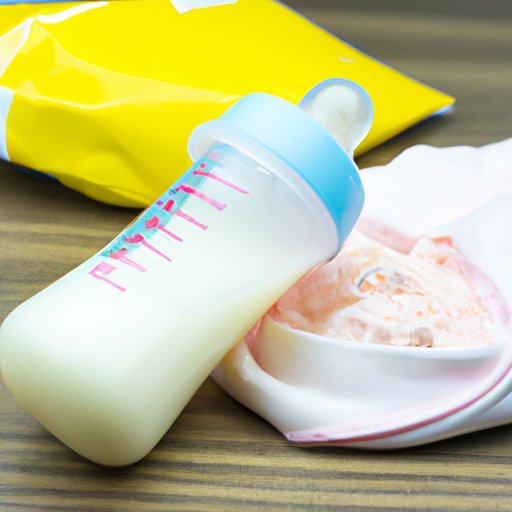
Introduction
One of the most common questions that new mothers ask is whether it is okay to mix breast milk and formula. While both breastfeeding and formula feeding have their own set of pros and cons, many new mothers often face the dilemma of whether to exclusively breastfeed, exclusively formula feed, or mix breast milk and formula. In this article, we will explore the topic of mixing breast milk and formula, weigh the risks and benefits, and provide a comprehensive guide for new mothers.
Confronting the Breast Milk and Formula Dilemma: What the Experts Say
According to experts, it is generally safe to mix breast milk and formula – as long as the formula is prepared correctly and the mixture is given to the baby right away. However, there are a few important things to consider before mixing the two. Some mothers choose to mix breast milk and formula if they are experiencing a low milk supply, or if they need to supplement with formula due to other issues. However, it is always a good idea to consult with a pediatrician before making any changes to a baby’s feeding routine in case there are any underlying health issues or concerns.
Mixing Breast Milk and Formula: Pros and Cons for Your Baby’s Health
Many experts agree that breast milk is the best source of nutrition for babies because it provides all the necessary nutrients and antibodies that a baby needs to develop and grow. Breastfeeding also offers benefits such as promoting bonding and intimacy between a mother and baby, and reducing the risk of certain health conditions such as allergies and asthma. On the other hand, formula feeding offers benefits such as convenience and flexibility, and can be a good option for mothers who cannot or choose not to breastfeed.
When it comes to mixing breast milk and formula, there are both pros and cons to consider for your baby’s health. Some pros of mixing are that it can help ensure that the baby is receiving enough nutrition if the mother’s milk supply is low, or if the baby needs more than what breast milk can provide. However, if formula is not prepared correctly, it can cause digestive issues or even lead to an infection.
The Debate Over Mixing Breast Milk and Formula: Understanding the Risks and Benefits
Mothers may choose to mix breast milk and formula for a variety of reasons. For instance, a mother who is returning to work might choose to mix breast milk and formula in order to provide the baby with enough nutrition while she is away. However, there are potential risks associated with mixing breast milk and formula. Experts suggest that if a mother is mixing the two, she should ensure that the formula is prepared correctly and that the mixture is given to the baby immediately. Additionally, mixing the two can cause digestive issues or even lead to an infection if the mixture is not prepared properly.
Despite the potential risks, there are benefits associated with mixing breast milk and formula. For example, mixing can help ensure that the baby is getting enough nutrition and calories. In certain situations, mixing may even help the baby tolerate a new formula more easily.
Is it Safe to Mix Breast Milk and Formula? A Comprehensive Guide for New Mothers
If a mother is considering mixing breast milk and formula, it is important to do so safely in order to avoid any risks or potential health issues for the baby. Here are some tips for mixing breast milk and formula:
- Wash your hands thoroughly before preparing the mixture
- Prepare the formula according to instructions
- Add the appropriate amount of breast milk and formula to a bottle, and shake until it is well-mixed
- Give the mixture to your baby immediately, or store it in the refrigerator for up to 24 hours
It is also important to note that breast milk and formula should never be mixed together and then frozen. This can cause bacteria to grow in the milk and affect your baby’s health. If breast milk and formula need to be stored together, they should be stored separately and mixed just before feeding.
Combining Breast Milk and Formula – Is it Necessary and How to Do it Properly?
Mixing breast milk and formula may not be necessary for all babies. However, some situations may call for it, such as if a mother is experiencing a low milk supply, or if the baby needs more nutrition than what breast milk can provide. When mixing breast milk and formula, it is important to do so properly in order to avoid any potential health risks. Here are some tips for combining breast milk and formula:
- Always consult with a pediatrician before making any changes to a baby’s feeding routine
- Use the correct proportions of breast milk and formula – typically, one part formula to two parts breast milk is a good starting point, but you may need to adjust the proportions based on your baby’s needs
- Introduce mixed feeding gradually – abrupt changes to a baby’s feeding routine can cause digestive issues or other health problems. Mixing should be introduced slowly over a period of several days to allow the baby’s digestive system time to adjust
Conclusion
In conclusion, mixing breast milk and formula can be safe and beneficial for some babies. However, it is important to understand the risks and benefits, and to consult with a pediatrician before making any changes to a baby’s feeding routine. By following the proper instructions and precautions for mixing breast milk and formula, new mothers can ensure that their babies are getting the nutrition they need, while also promoting their overall health and development.





